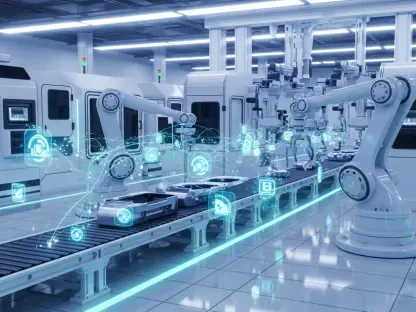In a world where manufacturing races to keep pace with relentless demand, what happens when two industry giants combine forces to shatter traditional boundaries and redefine the future? Siemens, a powerhouse in industrial automation, and Capgemini, a titan of technology consulting, are forging a path that could transform how products are made. Their collaboration is not just about incremental improvements—it’s about a seismic shift in industrial operations, driven by artificial intelligence and digital innovation. This partnership promises to tackle inefficiencies and sustainability challenges head-on, offering a glimpse into a smarter, more connected industrial era.
Why This Alliance Is a Big Deal
The manufacturing sector stands at a crossroads, grappling with fragmented systems, escalating production demands, and urgent calls for environmental responsibility. Industries ranging from aerospace to pharmaceuticals are under pressure to deliver faster, better, and greener. Siemens and Capgemini’s union emerges as a critical response to these challenges, blending deep technological expertise with strategic vision. Their mission is to transform the industrial landscape by integrating advanced tools with actionable insights, ensuring companies can thrive amid rapid global changes.
This alliance holds particular weight in bridging the long-standing divide between information technology (IT) and operational technology (OT). By focusing on seamless connectivity and sustainability, the partnership aligns with broader industry trends toward digitalization. It’s a timely intervention for manufacturers striving to maintain a competitive edge while meeting ambitious ecological targets, positioning this collaboration as a catalyst for widespread change.
The Core Strategies Driving Change
At the heart of Siemens and Capgemini’s approach lies a set of innovative strategies designed to overhaul manufacturing processes. Their AI-native solutions are built with artificial intelligence embedded from the outset, not tacked on as an afterthought. This method enhances productivity and slashes time-to-market, offering 16 specialized capabilities tailored for complex industrial environments, ensuring precision and scalability across diverse applications.
Another cornerstone is the integration of IT and OT, historically separate domains that have hindered efficiency. Through technologies like digital twins—virtual replicas of physical systems—the partnership enables real-time simulation and optimization across engineering and production. Additionally, a strong emphasis on sustainability drives their efforts, with tools aimed at reducing energy consumption and emissions, supporting industries in their decarbonization journeys with measurable impact.
Real Impact Across Industries
The tangible outcomes of this collaboration speak volumes about its potential. Take Airbus, for instance, where energy system twins have been deployed across four sites in the US and UK. These digital models simulate strategies that target a 20% reduction in energy use and an 85% drop in Scope 1 and 2 emissions by 2027, showcasing how technology can drive environmental progress without sacrificing operational goals.
Elsewhere, in the pharmaceutical sector, Sanofi has benefited from AI-powered Manufacturing Execution Systems. Replacing outdated paper-based processes with digital batch records, this initiative has cut review times by 70% and production discrepancies by 80%, bolstering compliance and quality. Similarly, at GravitHy, a green steel innovator, digitalized operations have paved the way for a 10% reduction in hydrogen production costs, underlining the partnership’s versatility across sectors.
Leadership Insights and Proven Results
Leaders from both companies articulate a clear vision for this transformative alliance. Cedrik Neike of Siemens highlights the synergy, noting, “Combining our cutting-edge technology with strategic expertise creates a dynamic force for digital innovation, empowering clients to evolve rapidly.” Aiman Ezzat of Capgemini complements this by stating, “Guidance through intricate industrial challenges is our strength, delivering customized solutions that scale effectively.” Their unified perspective reinforces a dedication to impactful outcomes.
Beyond rhetoric, the partnership’s track record adds credibility. Having supported over 100 clients across 20 countries, their joint efforts have delivered consistent, quantifiable benefits. From Airbus’s energy savings to Sanofi’s streamlined processes, the data—such as 70% faster reviews and 10% cost reductions at GravitHy—validates their approach, proving that this collaboration is more than just a concept; it’s a tested solution.
Steps for Manufacturers to Follow Suit
For companies inspired by Siemens and Capgemini’s model, adopting AI-driven manufacturing is within reach with a structured approach. Start by embedding AI into systems at the design stage, focusing on pilot projects in areas like predictive maintenance or quality assurance. Assessing and closing gaps between IT and OT systems is also crucial, using platforms like digital twins to test and refine operations virtually before real-world application.
Prioritizing sustainability through digital monitoring of energy use and setting clear decarbonization targets can yield significant environmental gains. Partnering with experienced technology and consulting firms ensures tailored solutions, while a gradual scaling strategy—starting small and expanding as results build confidence—mirrors Capgemini’s plan to grow certified professionals on Siemens platforms. These practical steps offer a roadmap for manufacturers to modernize and align with global sustainability imperatives.
Reflecting on a Transformative Journey
Looking back, the alliance between Siemens and Capgemini stood as a beacon of innovation in manufacturing’s evolving landscape. Their integration of AI, digital twins, and sustainability-focused solutions reshaped how industries approached production challenges. The successes at Airbus, Sanofi, and GravitHy underscored the power of combining technological strength with strategic foresight. For manufacturers worldwide, the next step involved embracing these digital tools, forging partnerships, and setting bold targets for efficiency and environmental impact. This journey highlighted that transformation was not just possible—it was essential for a sustainable industrial legacy.









